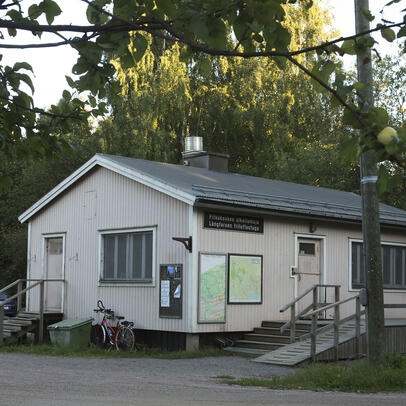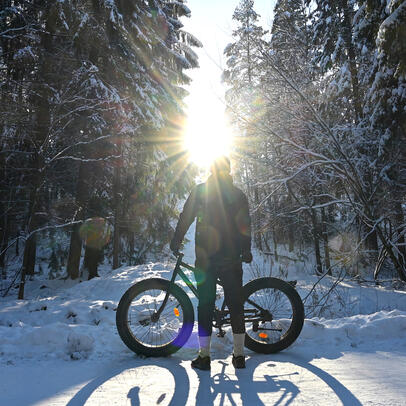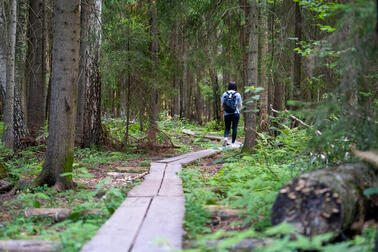
Central Park in brief
Central Park is a more than 100-year-old diverse nature and outdoor recreation area located in the centre of Helsinki. Spanning approximately 10 kilometres, Central Park stretches from Töölönlahti bay in the south to Haltiala on the northern border of the city. The main route of Central Park runs through the park from south to north.
People travel through Central Park and go there for hikes, exercise and recreation. There are guided hiking trails in the area, and many Helsinki residents commute through Central Park. In the winter, some of the hiking trails are used as skiing trails.
The nature of Central Park is diverse and the terrain varies. The park has vast forest areas, landscape fields and meadows. The southernmost part of the park is a more park-like urban environment.
New in Central Park

Central Park mountain bike trail
A new 16-kilometre mountain bike trail has been established in Central Park. The trail can also be used by other people enjoying the outdoors.
It is hoped that the route will guide mountain biking so that the excessive wear and tear of nature in Central Park's sensitive natural sites is reduced.

Almost 500 new signs and Central Park guide map
Cartographic signs have been added at the hiking lodges and the main intersections together with new signposts at the intersections. The signs guide from Töölönlahti Bay to the Haltiala, northern part of Central Park. The Central Park guide map indicates, for example, hiking and skiing trails, jogging trails, hiking lodges as well as stops and parking areas.
Download Central Park guide map (pdf, inaccessible)(Link leads to external service)
Walking in Central Park, nature and history
In the northern part of Central Park, you will find the popular Haltiala and Paloheinä nature and outdoor recreation areas. Further south in Central Park are Maunula, Pirkkola, Ruskeasuo and Laakso. There is a lot to see and do in these areas.
Get to know Central Park’s outdoor and nature recreation in the section Central Park outdoor recreation areas and services
Trails and routes
Many trails and paths crisscross in Central Park. Moving around in the park will be easier when new signs will be installed in Central Park during 2023 - 2024. There will be cartographic signs at the hiking lodges and the main intersections, and signposts at the intersections. You can also walk in Central Park outside the trails and pick mushrooms and berries. In some of the nature reserves, access is restricted.
On illuminated routes, the lights are turned off at 11:00 p.m. and turned on at 6:00 a.m.
See Central Park's routes, hiking lodges and sports parks on a map in the section Things to do in Central Park or on the guide map: Download the Central Park guide map (pdf, inaccessible)(Link leads to external service)
Pay attention to other park users
Keskuspuisto on Helsingin suosituin ulkoilualue, jossa on vuosittain yli 2 miljoonaa ulkoilukäyntiä. Onkin tärkeää, että ulkoilijat ja muut alueen kautta kulkevat huomioivat toisensa.
There are many cyclists and pedestrians on the hiking trails. When encountering others and when overtaking, cyclists must slow down sufficiently for safety and ring their bell or indicate their presence otherwise vocally to ensure safe overtaking.
Ladut: Talvella aurattu ulkoilureitistö risteää latujen kanssa, mikä pyöräilijöiden tulee ottaa erityisesti huomioon. On myös tärkeää, että laduilla ei kävellä.
General rules
In all outdoor areas, observe Everyman’s Rights and rules and move responsibly in nature:
The nature of Central Park is that of the typical lush southern Finnish coniferous forest. Grove-like and fresh coniferous forests and herb-rich forests are common. Mature spruce-dominated forests and old mixed forests prevail.
The age of the forests varies between 60 and 100 years, and many forests have trees of different ages. The oldest spruce and silver birch forests in Central Park have reached the age of 100–120 years, and they have begun to show signs of deterioration, including small-scale insect damage.
The condition of the forest areas is monitored and the aim is to care for them methodically, in order to prevent the further spread of damage.
Read more about Central Park’s nature
Central Park got its start in 1911 when architect Bertel Jung drew up a park plan that included Töölönlahti and its surroundings. Central Park was established in 1914, after which it was finally expanded to the Vantaa River through a land purchase in 1934.
During the wars of 1941–1945, extensive logging of firewood was carried out in Central Park and elsewhere in the city's forests. Since 1952, Central Park's forests have been managed systematically as outdoor and recreational areas for city residents, while also safeguarding nature values.
At the end of the 20th century and in the 21st century, nature reserves have been established in Central Park. The management of the forests has promoted the biodiversity of Central Park and developed opportunities for outdoor activities for an ever-increasing number of visitors.








